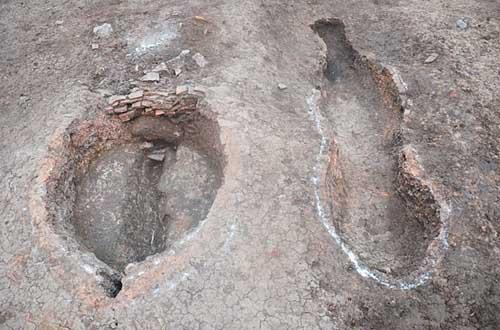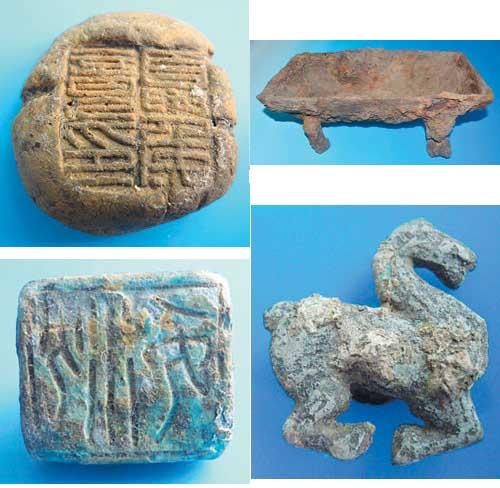Chinese Institute of Archaeology
Source - http://www.kaogu.cn/en/detail.asp?ProductID=3631
The Guyang city-site, located at 1 km south of the downtown of Guzhen County in Bengbu, Anhui, on the southern bank of Hui River. Administratively it belongs to Guyang village, Liancheng Township of Guzhen County. Early in Western Han period Guyang County was established here. At present, only sections of city walls are preserved on the surface, among them the south and west walls are in good condition. Judged from the length and extension of walls, the city is basically in rectangular shape with each side ca. 1000 m long, covering an area about 1 million square meters.
Although many city-sites of Han period have been found across the country, they are quite rare on the reaches of Huai River. Entrusted by Anhui Antique Bureau and Anhui Provincial Archaeological Institute, archaeologists from Nanjing University have conducted a two-month excavation to the site.

The fieldwork started from middle September 2011, and ended in middle November. Firstly in the northwest part of the site 22 pits assigned in south-north direction each measuring 5m×5m were excavated. Then pits in the middle part and northeast part were dug. Archaeologists found 5 kiln sites, 11 ceramic remains, 3 house sites, 9 foundation trenches, 2 ash ditches, 1 tomb, 69 ash pits, 1 drainpipe, 1 curbstone and 6 urns.
The most important finds are a group of kilns at the center of the excavation area, including Kiln YL1, Kiln YL3 and Kiln YL4. The Kiln YL1 is in nearly an oval shape and is well-preserved. It consists of a flue, a kiln bed and a vent. The kiln is sealed with tiles. In the filling earth there remain many pieces of slag and animal bones. The Kiln YL3 is in irregular shape, with the east part higher than the west, and is in poor state of preservation. The Kiln YL4 has an oval-shaped plan and is also seriously destroyed.
Archaeologists found a road and a section of drainpipe. The road is located in the southeast area. It remains a row of bricks as the curbstone and a large elongate area of red burnt earth, which probably were the road surface. The pipe made of red clay ceramic was found at the east of the road, only remaining the lower part in arc shape. The road and the pipe were buried in the same layer with that of the kilns. Therefore they could be dated to the approximate periods.
Among the 69 ash pits some are very valuable. For example the Ash pit H52, which was found at the south most of the excavation area, yielded various objects including bronze basins, iron animal head applique, arrow heads, ceramic building roofs, bronze brushes, millstones, stone balls, floor bricks, jars, coins and vessel handles. Some pits contain plenty of seals and burnt earth.
Totally 6 urn remains have been found in some pits and 5 of them were uncovered, yielding some bone fragments and a human skull.
Ceramic piles, for example TD8 and TD10, were found in the north most area. They are mainly gray clay tile pieces, including arc shaped and flat tiles.
There are 3 house foundations; all were found in the middle of the excavation area. The House F1 has a plan in the shape of 凸.

The excavation yields a great deal of artifacts, which are made of bronze, iron, ceramic and stone. There are a great number of seals with various characters, telling that they are mostly private items. Bronze objects are mainly various coins, crossbows, mirrors, belt hookers and arrow heads. There is a bronze belt hooker decorating with a running horse. Iron wares are mainly farming implements. Some iron thorns are also found. In the Ash pit H48 an iron baking tray has been found.
Numerous in variety tile ends were collected. They are engraved with cloud pattern, Chinese characters, images and persimmon-stem shaped patterns. Chinese characters read “Qianqiu Wansui” and “Yang”. The latter word probably was originally “Guyang”, with the former character “Gu” lost. Ceramic wares include celadon, white porcelain, white and blue porcelain. Most of them only remain the bottom or mouth. Stone objects are mainly millstones, mortars and whetstones.
The excavation to the Guyang city-site is a new progress for study on the Han Dynasty county sites on the reaches of Huai River. The achievement provides new materials for exploring the social history of Han dynasties of this area. (Translator: Tong Tao)